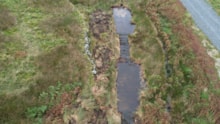16 December, 2024
Habitat creation effort paying off at Cairnsmore of Fleet

More than 15,000 trees have been planted as part of a major effort to create and expand important habitats at Cairnsmore of Fleet National Nature Reserve (NNR).
Staff and volunteers have planted around 3,000 native trees and hedgerow plants each year since 2020, with the aim of linking the existing pockets of upland oak woodland in the old In-Bye part of the reserve.
Blocking ditches to create ponds has also been a key part of efforts to give nature a boost in this area. Several ponds of different sizes have been created, which are already encouraging a wider variety of wildlife.
Meanwhile bracken and old pasture has been cleared to sow new areas of acid grassland on the floodplain. Wildflower species thrive in nutrient poor environments, and the reserve has been sowing yellow rattle, a plant that helps to weaken the old nutrient-rich pasture grasses, allowing space for more delicate native wildflowers.
Suzanne McIntyre, NatureScot’s Nature Reserve Manager for South Scotland, said: “The In-Bye is one of the most accessible parts of the reserve for visitors, and our team have really been focussing efforts on improving biodiversity here over the past few years, with help from the Fleet Valley Volunteer Group.
“We’ve been planting in a naturalistic low-density pattern to allow room to develop a varied undergrowth. We’ve planted a range of species such as oak, hazel, rowan, holly, hawthorn and birch which helps with soil formation and provides shelter but not too much shade.
“We haven’t needed to plant up the ponds, which have colonised rapidly naturally. We have been delighted to find a whole range of species using the new ponds already, from common frogs and toads, to newts, great diving beetles, mayflies, damselflies and dragonflies.
“We hope that in years to come visitors will be able to enjoy thriving woodland and wetland habitats in this area, supporting a much wider range of plants and animals.”
Most of the wider nature reserve is blanket bog or peat, which has suffered damage from historic activities such as drainage ditches, as well as from the impact of climate change with increased rainfall speeding up the erosion on existing gullies.
In these areas, the reserve team has been continuing restoration work aimed at halting this water loss, including using the peat itself to create dams across the drains and ditches, slowing the flow off the bog and raising the water table across a wide area.
ENDS
Contact information
- Name
- NatureScot Media
- Telephone
- 0131 316 2655
- media@nature.scot
Notes to editors
Find out more about Cairnsmore of Fleet National Nature Reserve.
There are 43 National Nature Reserves in Scotland. These are special places that look after some of the best of Scotland’s nature on behalf of everyone who lives or visits Scotland, and they provide unique opportunities to visit, enjoy and learn more about Scotland’s nature. For more information, see see www.nnr.scot
NatureScot is Scotland's nature agency. We work to enhance our natural environment in Scotland and inspire everyone to care more about it. Our priority is a nature-rich future for Scotland and an effective response to the climate emergency. For more information, visit our website at www.nature.scot or follow us on X at https://x.com/NatureScot
’S e NatureScot buidheann nàdair na h-Alba. Bidh sinn a’ neartachadh àrainneachd na h-Alba agus a’ brosnachadh dhaoine gu barrachd suim a chur ann an nàdar. Tha e mar phrìomhachas againn gum bi nàdar na h-Alba beairteach agus gun dèilig sinn gu h-èifeachdach le èiginn na gnàth-shìde. Tha an tuilleadh fiosrachaidh aig www.nature.scot no air X aig https://x.com/NatureScot
Downloads

Cairnsmore of Fleet NNR - Newly created pond near the viaduct on the old In Bye ©Fraser Wilson/NatureScot






